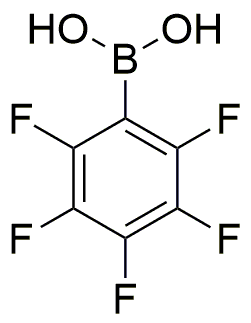Pentafluorophenylboronic acid is widely utilized in research focused on:
- Drug Development: It serves as a key intermediate in the synthesis of pharmaceutical compounds, particularly in the development of targeted therapies for cancer and other diseases.
- Material Science: This compound is used in the creation of advanced materials, such as polymers and coatings, that require enhanced chemical stability and resistance to degradation.
- Organic Synthesis: It acts as a versatile reagent in cross-coupling reactions, allowing chemists to construct complex organic molecules efficiently.
- Sensor Technology: Pentafluorophenylboronic acid is employed in the development of chemical sensors that detect biomolecules, providing valuable tools for diagnostics and environmental monitoring.
- Fluorinated Compounds: Its unique fluorinated structure makes it valuable in the synthesis of fluorinated compounds, which are important in various applications, including agrochemicals and specialty chemicals.
General Information
Properties
Safety and Regulations
Applications
Pentafluorophenylboronic acid is widely utilized in research focused on:
- Drug Development: It serves as a key intermediate in the synthesis of pharmaceutical compounds, particularly in the development of targeted therapies for cancer and other diseases.
- Material Science: This compound is used in the creation of advanced materials, such as polymers and coatings, that require enhanced chemical stability and resistance to degradation.
- Organic Synthesis: It acts as a versatile reagent in cross-coupling reactions, allowing chemists to construct complex organic molecules efficiently.
- Sensor Technology: Pentafluorophenylboronic acid is employed in the development of chemical sensors that detect biomolecules, providing valuable tools for diagnostics and environmental monitoring.
- Fluorinated Compounds: Its unique fluorinated structure makes it valuable in the synthesis of fluorinated compounds, which are important in various applications, including agrochemicals and specialty chemicals.
Documents
Safety Data Sheets (SDS)
The SDS provides comprehensive safety information on handling, storage, and disposal of the product.
Product Specification (PS)
The PS provides a comprehensive breakdown of the product’s properties, including chemical composition, physical state, purity, and storage requirements. It also details acceptable quality ranges and the product's intended applications.
Certificates of Analysis (COA)
Search for Certificates of Analysis (COA) by entering the products Lot Number. Lot and Batch Numbers can be found on a product’s label following the words ‘Lot’ or ‘Batch’.
*Catalog Number
*Lot Number
Certificates Of Origin (COO)
This COO confirms the country where the product was manufactured, and also details the materials and components used in it and whether it is derived from natural, synthetic, or other specific sources. This certificate may be required for customs, trade, and regulatory compliance.
*Catalog Number
*Lot Number
Safety Data Sheets (SDS)
The SDS provides comprehensive safety information on handling, storage, and disposal of the product.
DownloadProduct Specification (PS)
The PS provides a comprehensive breakdown of the product’s properties, including chemical composition, physical state, purity, and storage requirements. It also details acceptable quality ranges and the product's intended applications.
DownloadCertificates of Analysis (COA)
Search for Certificates of Analysis (COA) by entering the products Lot Number. Lot and Batch Numbers can be found on a product’s label following the words ‘Lot’ or ‘Batch’.
*Catalog Number
*Lot Number
Certificates Of Origin (COO)
This COO confirms the country where the product was manufactured, and also details the materials and components used in it and whether it is derived from natural, synthetic, or other specific sources. This certificate may be required for customs, trade, and regulatory compliance.


